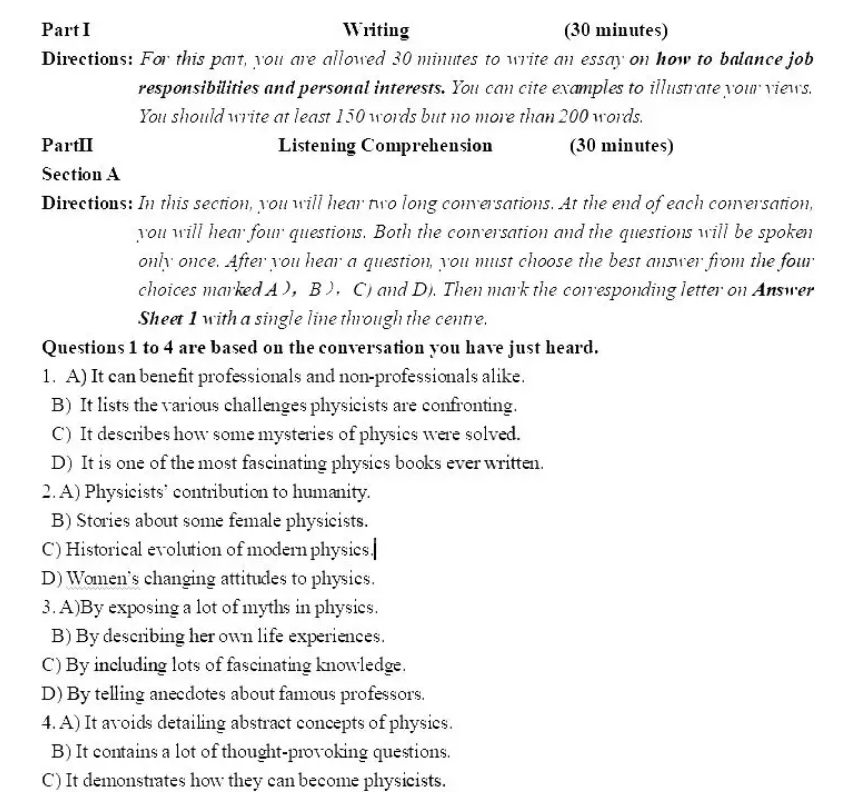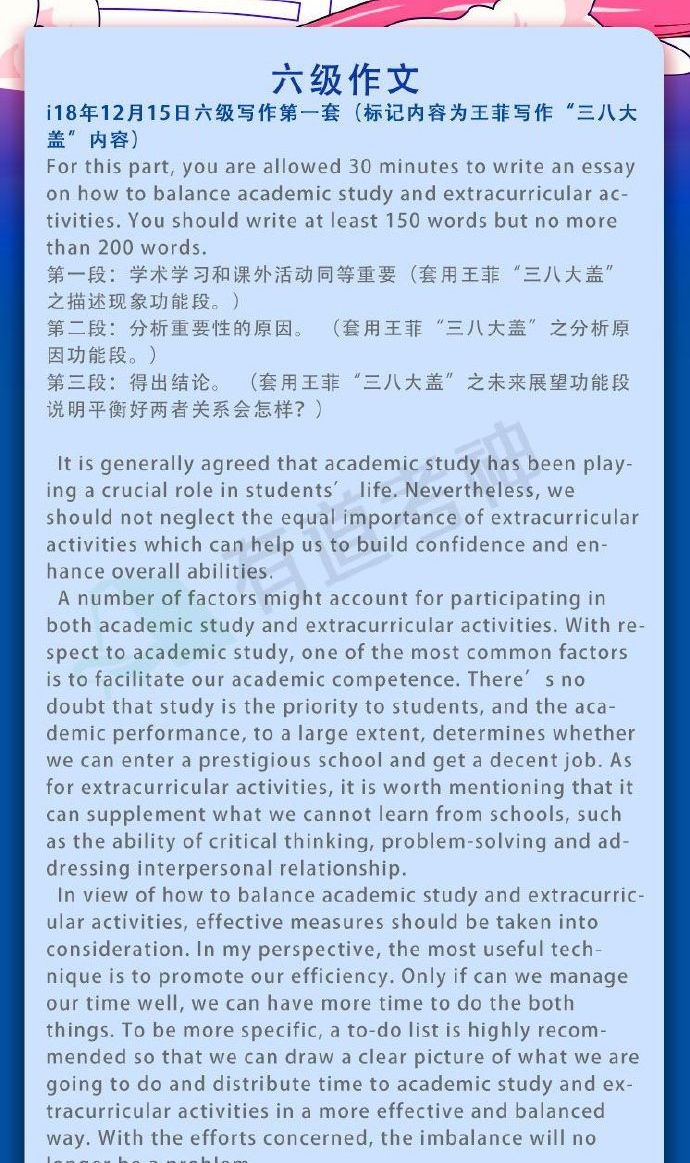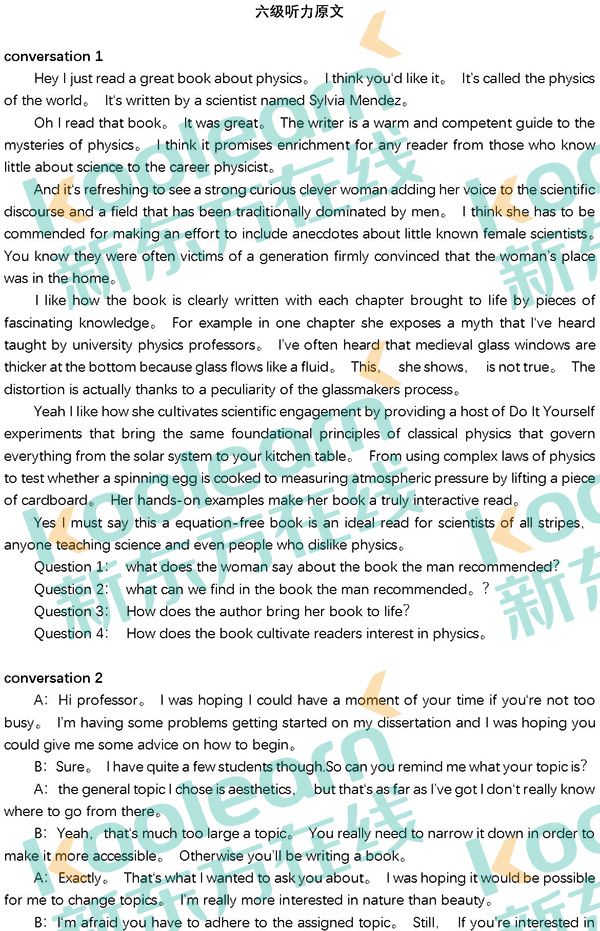07年全国硕士研究生入学考试英语模拟试题二
|
Section I Use of English Directions: Read the following text. Choose the best word(s) for each numbered blank and mark A, B, C or D on ANSWER SHEET 1. (10 points) There is growing interest in East Japan Railway Co., one of the six companies, created out of the privatized national railway system. In an industry lacking exciting growth 1,its plan to use real-estate assets in and around train stations 2 is drawing interest. In a plan called “Station Renaissance” that it 3 in November, JR East said that it would 4 using its commercial spaces for shops and restaurants, extending them to 5 more suitable for the information age. It wants train stations as pick-up 6 for goods 7 books, flowers and groceries purchased 8 the Internet. In a country 9 urbanites depend heavily on trains 10 commuting, about 16 million people a day go to its train stations anyway, the company 11. So, picking up purchases at train stations spare 12 extra travel and missed home deliveries. JR East already has been using its station 13 stores for this purpose, but it plans to create 14 spaces for the delivery of Internet goods. The company also plans to introduce 15 cards—known in Japan as IC cards because they use integrated 16 for holding information— 17 train tickets and commuter passes 18 the magnetic ones used today, integrating them into a single pass. This will save the company money, because 19 for IC cards are much less expensive than magnetic systems. Increased use of IC cards should also 20 the space needed for ticket vending. 1. [A]prospects [B]outlooks [C]expectations [D] spectacles 2. [A]articulately [B] originally [C] reluctantly [D] creatively 3. [A]unveiled [B] concealed [C]demonstrated [D] displayed 4. [A]come round [B] go beyond [C] take over [D] set out 5. [A]endeavors [B] enterprises [C]functions [D]performances 6. [A]locations [B]entrances [C]vicinities [D]districts 7. [A] for example [B] like [C]except [D]other than 8. [A]from [B]above [C] over [D]in 9. [A]when [B]where [C]which [D]that 10. [A] of [B]in [C]about [D] for 11. [A]figures [B] speculates [C] exhibits [D] convinces 12. [A]clients [B]consumers [C]merchants [D] businesses 13. [A]conjunction [B]ornament [C]expenditure [D] convenience 14. [A]dedicated [B]devoted [C]designated [D]destined 15. [A]clever [B]intelligent [C]ingenious [D]smart 16. [A]chorus [B]circus [C]circumference [D]circuit 17. [A]as [B] for [C]with [D] of 18. [A]as well as [B]instead of [C]more than [D]but for 19. [A]devices [B]instruments [C]readers [D]examiners 20. [A]shrink [B]narrow [C]descend [D]reduce Section II Reading Comprehension Part A Directions: Read the following four texts. Answer the questions below each text by choosing A, B, C or D. Mark your answers on ANSWER SHEET 1. (40 points) Text 1 Save the mighty elephant! Who could argue? Well, the hippopotamus might. In 1989, with the elephant facing the threat of extinction, the nations of the world agreed to ban trade in elephant ivory. Now, ivory hunters who once shot elephants for their tusks are shooting hippos for their teeth. If nothing is done, experts say, the hippo may be wiped out in some areas of Africa. The hippo, laments Dr. Simon Lyster of the World Wide Fund for Nature, "is the forgotten beast.” Unfortunately for hippos, they're easy targets. They like to gather in herds at muddy pools and just sit there, virtually motionless. Hunters simply shoot the hippos in the water. Not surprisingly, there's a new campaign to save the hippo. At the annual Convention on International Trade in Endangered Species in Florida this week, France, Belgium and Benin will propose strict quotas and monitoring of the hunting and trade in hippos and hippo parts. The data so far are spotty—but generally gloomy for the hippo. From 1988 to 1992, the number of hippo teeth carved in Hong Kong and re-exported rose from 224 to 3 868—with most of those shipments bound for the United States. The trade in hippo ivory follows much the same route as the old trade in elephant tusks— from hunters in Africa through middlemen in Europe to carvers in Hong Kong and Japan. Hippo ivory is a bit more brittle and less desirable than elephant ivory, so it sells for a good deal less—about $ 50 to $ 70 per kilo wholesale, compared with $ 400 to $ 500 for elephant ivory. Once it is fashioned into trinkets and jewelry, however, few consumers can tell the difference. The trade is booming. In a rare census of African hippos last year, conservationists were alarmed to find a population of only 160 000, or about a quarter the estimated number of elephants. Even in national parks where hippos live, protections are failing, in part because many nations had used proceeds from the sale of elephant tusks to pay park police. Now that income is gone, and some parks have become hunting grounds. Malawi is among many African nations that support new hippo protections; some are even moving unilaterally to save the herds. Zambia restricts hippo hunting to tourist expeditions in national parks and gives local people 35 percent of the tourist revenues. That should encourage locals to help fend off poachers and to quit hunting hippos themselves. And if ivory hunters do leave the hippo alone? They'll probably move on to other animals with carvable teeth, like walruses or whales. 21. We may infer from the text that the hippo is [A] an endangered animal species. [B] a kind of tourist games. [C] a special fish in rivers. [D] an African elephant. 22. When Dr. Lyster said sadly that the hippo "is the forgotten beast," (Line5—6,Paragraph l) he meant that [A] people had forgotten to make use of its teeth. [B] the hippo was threatening the existence of elephants. [C] there was an excessive number of hippos in Africa. [D] the world only remembered to save elephants. 23. We may infer that the hippo hunting and trading are thriving because [A] there has been no strict rules to control these activities before this week. [B] consumers like hippo teeth products better than those made of ivory. [C] there are fewer elephants left in Africa than hippos. [D] hunters find that hippos are easier to kill than elephants. 24. Some African countries tried to protect animals in national parks by [A] getting the locals involved in the trade of hippos. [B] reinforcing park police force. [C] sharing benefits from parks with the locals. [D] turning hunting grounds into national parks. 25. The last sentence implies that walruses or whales may [A] move to other places where foods are available. [B] become the next victim of hunters' targets . [C] outnumber elephants and hippos in the future. [D] become tourist attractions in African national parks. Text 2 For more than two decades, U. S. courts have been limiting affirmative-action programs in universities and other areas. The legal rationale is that racial preferences are unconstitutional, even those intended to compensate for racism or intolerance. For many colleges, this means students can be admitted only on merit, not on their race or ethnicity. It has been a divisive issue across the U. S., as educators blame the prolonged reaction to affirmative-action for declines in minority admissions. Meanwhile, activists continue to battle race preference- in courts from Michigan to North Carolina. Now chief executives of about two dozen companies have decided to plunge headfirst into this politically unsettled debate. They, together with 36 universities and 7 non-profitable organizations, formed a forum that set forth an action plan essentially designed to help colleges circumvent court-imposed restrictions on affirmative action. The CEOs' motive: "Our audience is growing more diverse, so the communities we serve benefit if our employees are racially and ethnically diverse" as well, says one CEO of a company that owns nine television stations. Among the steps the forum is pushing: finding creative yet legal ways to boost minority enrollment through new admissions policies; promoting admissions decisions that look at more than test scores; and encouraging universities to step up their minority outreach and financial aid. And to counter accusations by critics to challenge these tactics in court, the group says it will give legal assistance to colleges sued for trying them. "Diversity diminished by the court must be made up for in other legitimate, legal ways," says a forum member. One of the more controversial methods advocated is the so-called 10% rule. The idea is for public universities—which educate three-quarters of all U. S. undergraduates—to admit students who are in the top 10% of their high school graduating class. Doing so allows colleges to take minorities who excel in average urban schools, even if they wouldn't have made the cut under the current statewide ranking many universities use. 26. U. S. court restrictions on affirmative action signifies that [A] minorities no longer hold the once favored status. [B] the quality of American colleges has improved. [C] racial preferences has replaced racial prejudice. [D] the minority is on an equal footing with the majority. 27. What has been a divisive issue across the United States? [A] Whether affirmative action should continue to exist. [B] Whether this law is helping minorities or the white majority. [C] Whether racism exists in American college admission. [D] Whether racial intolerance should be punished. 28. CEOs of big companies decided to help colleges enroll more minority students because they [A] think it wrong to deprive the minorities of their rights to receive education. [B] want to conserve the fine characteristics of American nation. [C] want a workforce that reflects the diversity of their customers. [D] think it their duty to help develop education of the country. 29. The major tactic the forum uses is to [A] battle the racial preferences in court. [B]support colleges involved in lawsuits of racism, [C]strive to settle this political debate nationwide. [D] find legally viable ways to ensure minority admissions. 30. If the 10% rule is applied, [A] the best white high school students can get into colleges. [B] public universities can get excellent students. [C] students from poor rural families can go to colleges. [D] good minority students can get into public universities. Text 3 Positive surprises from government reports on retail sales, industrial production and housing in the past few months are leading economists to revise their real gross domestic product forecasts upward, supporting the notion that the recession ended in December or January. Bear in mind: This recovery won't have the vitality normally associated with an upturn. Economists now expect real GDP growth of about 1.5% the first quarter. That’s better than the 0.4% the consensus projected in December, but much of the additional growth will come from a slower pace of inventory drawdowns, not from surging demand. Moreover, the economy won't grow fast enough to help the labor markets much. The only good news there is that jobless claims have fallen back from their spike after September 11 and that their current level suggests the pace of layoffs is easing. The recovery also does not mean the Federal Reserve will raise interest rates soon. The January price indexes show that inflation remains tame. Consequently, the Fed can take its time shifting monetary policy from extreme accommodation to relative neutrality. Perhaps the best news from the latest economic reports was the January data on industrial production. Total output fell only 0. 1%, its best showing since July. Factory output was flat, also the best performance in six months. Those numbers may not sound encouraging, but manufacturers have been in recession since late 2000. The data suggest that the factory sector finding a bottom from which to start its recovery. Production of consumer goods, for instance, is almost back up to where it was a yea: ago. That's because consumer demand for motor vehicles and other goods and the he: using industry remained healthy during the recession, and they are still growing in early 2002. Besides, both the monthly homebuilding starts number and the housing market index for the past two months are running above their averages for all of 2001, suggesting that homebuilding is off to a good start and probably won't be a big drag on GDP growth this year. Equally important to the outlook is how the solid housing market will help demand for home-related goods and services. Traditionally, consumers buy the bulk of their furniture, electronics, and textiles within a year of purchasing their homes. Thus, spending on such items will do well this year, even as car sales slip now that incentives are less attractive. Look for the output of consumer goods to top year-ago levels in coming months. Even the business equipment sector seems to have bottomed out. Its output rose 0.4% in January, led by a 0.6% jump computer gear. A pickup in orders for capital goods in the fourth quarter suggests that production will keep increasing—although at a relaxed pace—in coming months. 31. American economists are surprised to see that [A] their government is announcing the end of a recession. [B] US economy is showing some signs of an upturn so soon. [C] some economic sectors have become leading industries. [D] they have to revise the product forecasts so often. 32. The most encouraging fact about the US economy is that [A] employment rates have risen faster than expected. [B] the Federal Reserve will raise interest rates soon. [C] GDP is growing because of surging demand. [D] Industrial production has reached its lowest point. 33. Which of the following best brightens the future of US economy? [A] Business equipment. [B]Computer gear. [C] Housing market. [D]Motor vehicles 34. In spite of the good news, the author sounds relatively more reserved about [A] national GDP growth. [B]price indexes [C]output [D] the number of layoffs. 35. Which of following best summarizes the U. S. economic situation today? [A]All the data still show a bleak year in 2002. [B]It is slowly warming up with moderate growth. [C] Recession may come back anytime in the coming months. [D] Most sectors are picking up at a surprisingly fast pace. Text 4 Timothy Berners-Lee might be giving Bill Gates a run for the money, but he passed up his shot at fabulous wealth—intentionally—in 1990. That's when he decided not to patent the technology used to create the most important software innovation in the final decade of the 20th century: the World Wide Web. Berners-Lee wanted to make the world a richer place, not a-mass personal wealth. So he gave his brainchild to us all. Berners-Lee regards today's Web as a rebellious adolescent that can never fulfill his original expectations. By 2005,he hopes to begin replacing it with the Semantic Web—a smart network that will finally understand human languages and make computers virtually as easy to work with as ether humans. As envisioned by Berners-Lee,the new Web would understand not only the meaning of words and concepts but also the logical relationships among them. That has awesome potential. Most knowledge is built on two pillars: semantic and mathematics. In number-crunching, computers already outclass people. Machines that are equally adroit at dealing with language and reason won't just help people uncover new insights; they could blaze new trails on their own. Even with a fairly crude version of this future Web, mining online repositories for nuggets of knowledge would no longer force people to wade through screen after screen of extraneous data. Instead, computers would dispatch intelligent agents, or software messengers, to explore Web sites by the thousands and logically sift out just what's relevant. That alone would provide a major boost in productivity at work and at home. But there's far more. Software agents could also take on many routine business chores, such as helping manufacturers find and negotiate with lowest-cost parts suppliers and handling help-desk questions. The Semantic Web would also be a bottomless trove of eureka insights. Most inventions and scientific breakthroughs, including today's Web,spring from novel combinations of existing knowledge. The Semantic Web would make it possible to evaluate more combinations overnight than a person could juggle in a lifetime. Sure scientists and other people can post ideas on the Web today for others to read. But with machines doing the reading and translating technical terms, related ideas from millions of Web pages could be distilled and summarized. That will lift the ability to assess and integrate information to new heights. The Semantic Web, Berners-Lee predicts, "will help more people become more intuitive as well as more analytical. It will foster global collaborations among people with diverse cultural perspectives, so we have a better chance of finding the right solutions to the really big issues—like the environment and climate warming. " 36. Had he liked, Berners-Lee could have [A] created the most important innovation in the 1990s. [B] accumulated as much personal wealth as Bill Gates. [C] patented the technology of Microsoft software. [D] given his brainchild to us all. 37. The Semantic Web will be superior to today's web in that it [A] surpasses people in processing numbers. [B] fulfills users' original expectations. [C] deals with language and reason as well as number. [D] responses like a rebellious adult. 38. To search for any information needed on tomorrow's Web,one only has to [A] wade through screen after screen of extraneous data. [B] ask the Web to dispatch some messenger to his door. [C] use smart software programs called "agents. " [D] explore Web sites by the thousands and pick out what's relevant. 39. Thanks to the Web of the future, [A] millions of web pages can be translated overnight. [B] one can find most inventions and breakthroughs online. [C] software manufacturers can lower the cost of computer parts. [D] scientists using different specialty terms can collaborate much better. 40. The most appropriate title for this text is [A] Differences Between Two Webs. [B] The Humanization of Computer Software. [C] A New Solution to World Problems. [D] The Creator and His Next Creation. Part B Directions: In the following article, some sentences have been removed. For Questions 41—45, choose the most suitable one from the list A—G to fit into each of the numbered blank. There are two extra choices, which do not fit in any of the gaps. Mark your answers on ANSWER SHEET 1. (10 points) Drug use may be the most prominent controversy surrounding this summer's Olympic Games in Athens. But the second burning question concerns an entirely legal approach to getting the winning edge: namely, whether or not form-fitting fast-suits made from high-tech fabrics will decide which athletes bring home a medal. 41__________________________________________. Manufacturers have devoted considerable energy to developing various approaches to reducing drag. Nowhere is this competition more intense than in swimming. These days, anyone who shows up at the pool in a pair of tiny trunks is a loser. Fast suits are derigueur. Speedo, Tyr and Nike all produce them but the big battle will be between the two market leaders, Speedo and Tyr, because both companies have adopted different approaches to moving through water quickly. 42______________________________. The Speedo Fastskin FSII suit Phelps is using in Athens is a substantial improvement over Speedo's first-generation suit used at the Games in Sydney, Australia, four years ago, which was too restrictive, according to Lenny Krayzelburg, another U.S. swimmer who will be sporting the upgraded Speedo suit. He can tell the difference. 43_________________________________________________. Suit developers noted that although the shark is very streamlined, the shape and texture of its skin varies over its body, corresponding to varying flow conditions. Rough dermal denticles, for example, are found at the nose of a shark while smoother ones are located farther back, reflecting differences in flow at different points on the body. 44____________________________________________________. Virtual swimmers were added using CyberFX virtual mannequins----software also used in the making of movies such as Spiderman and The Matrix. The researchers also conducted tests using real mannequins and athletes in a real pool. 45_______________________________________________-. At points where bodies curve, another spandex-like material called Flexskin--joined to the other fabric by low-profile seams--enables greater mobility. Speedo suits also feature titanium-silicon scales on the inner forearm that grip the water better on down strokes. Lastly, rubber bumps across the chest help reduce another type of resistance called pressure drag. The overall effect, Speedo asserts, is a 4 percent reduction in passive drag for men and a 3 percent reduction for women. [A]The fast swimming suits might very well turn their wearers into superheroes of sorts, just like sharks in the vast expanse of sea. [B]After studying swimmers in a special donut-shaped pool--a lane-wide loop that enabled continuous swimming—a researcher found that boosting friction drag lessens two more detrimental types of drag: pressure drag, caused by the shape of the body, and wave drag, the wake created by the swimmer. Friction drag generally occurs at slower speeds, whereas pressure drag and wave drag are encountered as the swimmer moves faster. [C]These new garments will be most visible in high profile events such as swimming, but rowers and cyclists are sporting them as well. Although to the casual observer the suits might bring to mind costumes for the next Spiderman movie, they are less about good looks and more about their ability to reduce drag and thereby increase speed. In events in which the difference between gold and bronze is measured in tenths of a second, the fast suit an athlete wears may be the difference between winning a medal or not. [D]In the showdown of the suits, bettors might put their money on Speedo because it has the most experience in producing fast suits and because U.S. swimmer Michael Phelps, heavily favored to bring home a sack of medals, will be wearing one. [E]The fast swimming suits draw on sharks for inspiration and computers for execution. [F]To study how flow characteristics change as human swimmers move through water, Speedo adapted computational fluid dynamics software developed for Formula One racecars. The software was used to create a virtual flume. [G]The computer modeling showed that friction drag constitutes up to 29 percent of a swimmer's total drag when underwater--much more than the 10 percent previously thought. To combat friction drag, Speedo used different fabrics arranged to mimic sharkskin, altering the pattern according to the stroke used. The company also developed different suits for men and women. One fabric, the Fastskin, works like spandex to compress the body and limit muscle oscillation. Fastskin is designed to reduce friction drag by creating ridges and valleys similar to those on a shark's skin--the water skims over the ridges and skips the drag-inducing valleys in between them. Part C Directions: Read the following text carefully and then translate the underlined segments into Chinese. Your translation should be written clearly on ANSWER SHEET 2. (10 points) The value which society places on work has traditionally been closely associated with the value of individualism and as a result it has had negative effects on the development of social security. (46) It has meant that in the first place the amount of benefits must be small lest people's willingness to work and support themselves suffers. Even today with flat rate and earnings-related benefits, the total amount of the benefit must always be smaller than the person’s wages for fear of malingering. "The purpose of social security," said Huntford referring to Sweden's comparatively generous benefits, "is to dispel need without crossing the threshold of prosperity." (47) Second, social security benefits are granted under conditions designed to reduce the likelihood of even the boldest of spirits attempting to live on the State rather than work. Many of the rules surrounding the payment of unemployment or supplementary benefit are for this purpose. Third, the value placed on work is manifested in a more positive way as in the case of disability. People suffering from accidents incurred at work or from occupational diseases receive preferential treatment by the social security service compared with those suffering from civil accidents and ordinary illnesses. Yet, the stranglehold which work has had on the social security service has been increasingly loosened over the years. The provision of family allowances, family income supplements, the slight liberalization of the wages stop are some of the manifestations of this trend. (48) Similarly, the preferential treatment given to occupational disability by the social security service has been increasingly questioned with the demands for the upgrading of benefits for the other types of disability. It is felt that in contemporary industrial societies the distinction between occupational and non-occupational disability is artificial for many non-occupational forms of disability have an industrial origin even if they do not occur directly in the workplace. (49) There is also the additional reason which we mentioned in the argument for one benefit for all one-parent families, that a modern social security service must concentrate on meeting needs irrespective of the causes behind such needs. The relationship between social security and work is not all a one-way affair. (50) It is true that until very recently the general view was that social security " represented a type of luxury and was essentially anti-economic". It was seen as merely government expenditure for the needy. As we saw, however, redundancy payments and earnings-related unemployment benefits have been used with some success by employers and the government to reduce workers' opposition towards loss of their jobs. Section III Writing 66. Directions: Part A. You want to study at a certain foreign university. Write a letter to 1) inquire about the detailed situation there, and 2) ask about qualifications, fees and accommodation. Part B. Study the following cartoon carefully and write an essay of 200 words. Your essay should meet the requirements below: 1、describe the picture and interpret its meaning. 2、give your comments on it. 注:人类与互联网被锁链锁住了。 答案: 1. A 2. D 3. A 4. B 5. C 6. A 7. B 8. C 9. B 10. D 11. A 12. B 13. D 14. A 15. D 16. D 17. A 18. B 19. C 20. D Part A
21. A 22. D 23. A 24. C 25. B 26. A 27. B 28. C 29. D 30. D 31. B 32. D 33. C 34. A 35. B 36. B 37. C 38. C 39. D 40. D Part B C D E FG Part C 首先,这种观念认为,救济金的数额必须小,以免损害人们主动工作、自食其力的积极性。 其次,社会保障救济的发放是有条件的,设计这些条件,其目的是减少那些胆大妄为者企图依赖国家而非自食其力的可能性。 同样,社会保障体系给与职业残疾的优惠待遇越来越多的受到了质疑,人们要求提高其他类型的残疾的待遇。 此外,还有一个我们在讨论单亲家庭救济问题时所提及的理由,即一个现代的社会保障体系必须专注于满足需求,不管这些需求背后有何原因。 诚然,直到最近,普遍的观点依然认为社会保障体现的是一种享受,从本质上讲是反经济的。它仅仅被看作是为了贫困群体的政府开支。 |








